Overview
- Brief Narrative
- Cooking pot and lid brought with Gisela Berg and her family to Kenya where they lived after fleeing Cologne, Germany, in May/June 1939. They used this pot when preparing for Passover. The family was warned by neighbors to leave their home in Lechenich prior to the Kristallnacht pogrom of November 9-10, 1938. Their homes were vandalized and the family decided to leave Germany. Jill's father Josef, his brother George, and cousin Ernest fled to the Netherlands. They were arrested, but their uncle, Herman Meyer, hired a lawyer and the men were detained but not deported. This gave the family time to find a country where they could emigrate legally. A friend got them permits for British-ruled Kenya and eventually seventeen family members relocated to a cattle ranch near Nairobi. When the war ended in May 1945, the family decided to leave Africa. With the help of two cousins in the US, visas were obtained for the family. Gisela, 14, her sister Inge, 18, her parents Josef and Klara, and other family members arrived in Boston in March 1947.
- Date
-
emigration:
approximately 1939 June
- Geography
-
received:
Lechenich (Germany)
use: Kenya
- Credit Line
- United States Holocaust Memorial Museum Collection, Gift of Jill Berg Pauly
- Markings
- a. bottom, white paint : maker’s mark [shield flanked by rampant lions above an A]
- Contributor
-
Subject:
Jill B. Pauly
- Biography
-
Gisela (Jill) Renate Berg was born on May 1, 1933, to Josef and Klara Meyer Berg, in the small farming community of Lechenich, Germany, near Cologne. Her father was born there in 1896 to Max and Clara Davids Berg and had a brother Georg. Klara was born on November 13, 1904 in Linnich/Duhren to Bertha Schwarz Meyer. The Berg family had lived in the area since the 1600s. Josef and his brother worked with their father in his cattle business. Gisela had an older sister, Inge, born on March 27, 1929. The Bergs were an observant Jewish family. Max was the president of the local synagogue association.
After Hitler was appointed Chancellor in January 1933, antisemitic restrictions became increasingly harsh. Max had to arrange to have a non-Jew run their business.That May, one of Jill’s uncles began removing large sums of money and putting it in Dutch banks. Her sister, Inge, was no longer allowed to go to the public school and was sent to live with her grandmother where there was a Jewish school she could attend. Warned by neighbors of the impending Kristallnacht pogrom of November 9-10, 1938, many family members went into hiding in Cologne. Their homes were broken into and most of their belongings were destroyed. Several family members lived crowded into one apartment. They could no longer enjoy such things as picnics, going to the moves, and taking vacations. Gisela was never allowed outside; her parents were so worried about her safety that they kept her indoors at all times. The following week, Jill's father, his brother, George, and cousin, Ernest, fled to the Netherlands to escape arrest. They were imprisoned upon their arrival for illegal entry. The police told Herman Meyer, Klara’s brother and a resident of Holland, that the men were going to be deported back to Germany the next day. Herman contacted Maurice Silversmit, a leader in the Jewish community in Rotterdam. He told Herman to confront the police and tell them that written permission from The Hague was needed to return them to Germany. This gave him time to hire an attorney and request asylum for the three men. This was granted, but they had to remain in a detention center.
The family decided to look for another country where they could enter legally. Rosel (Marx) Berg, the wife of Karl, Josef’s cousin, had a relative who had emigrated to England in 1937. She called him daily from Cologne seeking assistance. This relative had a younger brother, Herman Strauss, who worked for a law firm in Kenya. He was able to secure the family visas for Kenya, a British colony at the time. Herman Strauss paid the mandatory 50 pounds per person for entry papers. Josef, George, and Ernest were released from the detention center in May on the condition that they leave for Kenya. Josef and George were the first members of the Berg family to arrive in Africa. They were interned in Camp Roever, then went to Nairobi where Josef rented a house from Lord and Lady Nepye. Ernest and Else Geisel were married in Maurice’s home before leaving Holland. They then went to Genoa, Italy, to meet more than a dozen members of the family who had left Germany: Inge, Jill, and their mother Klara, Sara Meyer Berg, wife of Joseph Berg and Gisela's maternal aunt, Rosel Marx Berg and her eighteen month old son Egon, Max and Clara Davids Berg, Jill’s paternal grandparents, and Berta Schwarz Meyer, her maternal grandmother. They sailed on board the SS Usambara and arrived in Mombasa, Kenya, in June 1939. Karl and Josef Berg arrived from Germany in August.
After WW II began with the German invasion of Poland in September 1939, the British government arrested all adult male foreigners, including Josef, his brothers, and his father. They were released a week later with the condition that they work on the farms of British citizens conscripted for war service. The Bergs were classified as enemy aliens and could leave their homes only with the permission of a police commissioner. In late 1939, the Bergs purchased a 375-acre farm in Limuru and 125 acres in Maguga. They raised thoroughbred cattle and pyrethrum, a flowering plant used to make insecticide. There were two houses, quite different from the ones they had left in Germany. Gisela’s home had a tin roof and cement floors, no electricity or indoor plumbing, although after two months they did have running water. Karl and Josef had brought the Sefer Torah when they left on the last boat out of Hamburg. The family held their own religious services on the farm since they could not drive to Nairobi on the Sabbath. Other members of the local Jewish community attended and, from 1945-1947, her uncle George was cantor at the Nairobi synagogue. In order to earn money for the children’s school fees, Klara ran a vacation boarding house. They had guests every weekend. Their paternal grandparents also lived with them. They tried to have tutors at the farm for the girls, but this did not work. They were enrolled in the Limuru Girls School for three months. Gisela had never attended school and the language difficulties and isolation made it very difficult. They transferred to a British boarding school in Nairobi and Gisela changed her name to Jill because of the rampant anti-Semitism, as well as anti-German and anti-immigrant feelings. Jill was harassed by the other children and accused by some teachers of being a German Jewish spy and beaten with a ruler. She and Inge had to board with strangers to keep kosher and lived with three or four different families in five years.
After Germany invaded the Netherlands in May 1940, Herman Meyer, Adolf and Erna Meyer Baum and their daughter Hannah, who had left Germany in 1937, fled to Kenya with one suitcase. With the birth of Philip John Berg to Ernest and Else in 1942, there were seventeen family members in all. For a while, they could send packages and correspond with relatives still in Europe. But by summer, that stopped. Clara had three siblings, Max, Valentin, and Moritz, who, with their wives, Betty, Hedwig, and Ida, were last heard from in July 1942 when Max wrote to say they were all now deported to Theresienstadt concentration camp. Jill’s maternal grandmother Berta died ca. 1942 of lung cancer. Her grandfather Max, age 82 years, also died that year. Her grandmother Clara died in 1945. They were buried in the Jewish cemetery in Nairobi. Around this time, Jill’s parents rented a house in Nairobi to be with the girls.
Many relatives from all sides of the family perished during the war. Clara, Jill's paternal grandmother, had nearly 100 cousins, but no survivors were found. The family made the decision to leave Kenya as soon as the war ended in May 1945. With the assistance of cousins John and Joseph Schwarz, who had emigrated to the US from Germany in 1939, they left Kenya on cargo boats and arrived in Boston in March 1947. The family settled in Vineland, New Jersey, where they operated a chicken farm and dairy business. In 1951, her sister, Inge, married Walter Katzenstein, a fellow refugee from Nazi Germany. In 1957, Gisela married Kurt Pauly. Kurt and his parents, Hugo and Selma Herz Pauly left Germany for Palestine in 1936, then left for the US in 1938. The couple had two children. Jill has volunteered for the USHMM for many years, sharing her experiences to teach "about hate and discrimination and the effects on mankind, and, always, every single time I enter the building, in memory of all who did not survive."
Physical Details
- Classification
-
Household Utensils
- Category
-
Cookware
- Object Type
-
Pots (lcsh)
- Physical Description
- a. Well used, deep, circular, metal cooking pot with a flared rim and a fitted lid (b), with dark red enamel paint on the exterior and gray with white speckles on the interior. Two c-shaped handles are attached to both sides just below the rim. A ridge at the base of the rim interior supports the lid when in use.
b. Well used, circular, convex metal lid with a raised rim for a pot (a), with dark red enamel paint on the top and gray with white speckles underneath. A c-shaped handle is attached to the top center. - Dimensions
- a: Height: 6.000 inches (15.24 cm) | Width: 13.875 inches (35.243 cm) | Depth: 11.000 inches (27.94 cm)
b: Height: 2.625 inches (6.668 cm) | Depth: 10.000 inches (25.4 cm) - Materials
- a : metal, enamel paint
b : metal, enamel paint
Rights & Restrictions
- Conditions on Access
- No restrictions on access
- Conditions on Use
- No restrictions on use
Keywords & Subjects
- Topical Term
- Holocaust, Jewish (1939-1945)--Germany--Personal narratives, Jewish. Jewish children in the Holocaust--Germany--Biography. Jewish families--Germany--Biography. Jewish refugees--Kenya--Biography. Jews, German--Kenya--Biography. Jews--Persecutions---Germany--Biography. World War, 1939-1945--Refugees--Kenya--Personal narratives, Jewish.
Administrative Notes
- Legal Status
- Permanent Collection
- Provenance
- The cooking pot and lid were donated to the United States Holocaust Memorial Museum in 2015 by Jill Berg Pauly.
- Funding Note
- The cataloging of this artifact has been supported by a grant from the Conference on Jewish Material Claims Against Germany.
- Record last modified:
- 2022-07-28 19:55:04
- This page:
- https://collections.ushmm.org/search/catalog/irn601646
Download & Licensing
In-Person Research
- By Appointment
- Request 21 Days in Advance of Visit
- Plan a Research Visit
- Request to See This Object
Contact Us
Also in Berg and Hermanns families collection
The collection includes a cake server, cooking pot, Kenyan statues, silver spoon, steamer trunk, prayer book, biographical materials, correspondence, photographs, and publications relating to the experiences of Clara and Max Berg and their extended family in Germany before their escape to Kenya and their life in Kenya during the Holocaust, and their postwar immigration to the United States and the Hermanns family and Julius Hermanns’ journey aboard the MS St. Louis, return to Europe, and internment in France. An accretion of five WWI medals was received in 2016.
Date: approximately 1880-1957
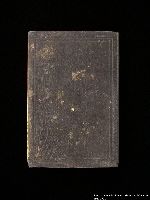
Prayer book
Object
Siddur inscribed and owned by George Berg in prewar Germany. The front cover and pages are defaced with dung as a result of the vandalization of the Berg home during Kristallnacht 9-10, 1938, in Lechenich, Germany.
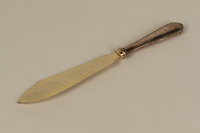
Silver vermeil cake server received as a wedding gift by a Jewish woman in prewar Germany
Object
Silver vermeil serving knife received as a wedding gift by Selma Herz upon her marriage to Hugo Pauly, circa 1927, in Eilendorf, near Aachen, Germany. It was a gift from Abraham Hollander, Anne Frank's maternal grandfather, who was a first cousin of Selma's mother, Caroline Menken Herz. The knife may have been a family heirloom that originally belonged to Rosa'a mother. Soon after the establishment of the Nazi dictatorship in 1933, the Herz family businesses were boycotted because they were Jewish. In early 1936, Selma and Hugo emigrated to Palestine with their 5 year old son, Kurt. They then emigrated to the United States in December 1938.
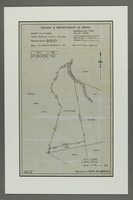
Berg and Hermanns families papers
Document
The Berg and Hermanns families papers consist of biographical materials, correspondence, and photographs documenting the Berg family and their escape to Kenya and the Hermanns family and Julius Hermanns’ journey aboard the MS St. Louis, return to Europe, and internment. The Berg family papers consist primarily of biographical materials, correspondence, and photographs documenting the Berg family from Germany and their escape to Kenya. Biographical materials include birth certificates, a military passbook, a marriage certificate, two family registers, certificates of good conduct, a letter of recommendation, travel papers, permissions, passports, a certified list of belongings Klara Berg took to Kenya, Kenyan certificates of registration, a miniature date book, an autograph book, and German and American identification cards documenting the Berg family and the Pauly family (Gisela Berg’s husband and his parents). Correspondence consists of letters and postcards among Berg family members, Pauly family members, and Berg relative Ella Schweizer. Berg family correspondence includes letters from Berg family members in Germany to those in Kenya as well as Red Cross inquiries about relatives deported to Theresienstadt and about family friends in Rotterdam. Pauly family correspondence consists of letters to Selma Pauly from family friend Josef Kaussen relating family news. Ella Schweizer postcards contain greetings. Photographs depict members of the Berg family and their relatives in Germany and Kenya. Printed materials include a clipping showing a map of Allied advances into North Rhine-Westphalia, a pocket calendar gifted to the Berg family from N. Menachemson, a program from a Nairobi Hebrew Congregation prayer service, and a survey map of Berg property in Kenya. Restitution materials include Pauly family correspondence and affidavits about their loss of property, health, and education during the Holocaust. The Hermanns family papers consist primarily of correspondence documenting Julius Hermanns’ efforts to flee Germany; his voyage aboard the MS St. Louis; his internment in Fresnay-sur-Sarthe, Saint Cyprien, Gurs, and Les Milles; and his relatives’ efforts to discover his fate as well as that of his wife and daughter and of Sol Meyer’s brother, Karl Meyer. Postcards from Karl to Sol describe his wartime life in Köln. The papers also include identification papers for Sol and Henrietta Meyer, clippings about the St. Louis and about Theresienstadt, Karl Meyer’s drawing of his mother, a satirical poem about the difficulties of emigration, and a report about Buchenwald. Photographic materials include photographs of a liberated concentration camp (possibly Buchenwald), Julius Hermanns, and Sol and Henrietta Meyer, and a photo album depicting the Hermanns family in Germany and the Meyers’ immigration voyage to New York in 1938.
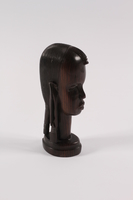
Kenyan wood bust of an African youth owned by a German Jewish refugee family
Object
Carved wooden bust of an African male in profile, with the hair and stretched earlobes of a Maasai warrior, acquired by Gisela Berg and her family in Kenya where they lived after fleeing Cologne, Germany, in May/June 1939. The family was warned by neighbors to leave their home in Lechenich prior to the Kristallnacht pogrom of November 9-10, 1938. Their homes were vandalized and the family decided to leave Germany. Jill's father Josef, his brother George, and cousin Ernest fled to the Netherlands. They were arrested, but their uncle, Herman Meyer, hired a lawyer and the men were detained but not deported. This gave the family time to find a country where they could emigrate legally. A friend got them permits for British-ruled Kenya and eventually seventeen family members relocated to a cattle ranch near Nairobi. When the war ended in May 1945, the family decided to leave Africa. With the help of two cousins in the US, visas were obtained for the family. Gisela, 14, her sister Inge, 18, and her parents Josef and Klara along with other family members, arrived in Boston in March 1947.
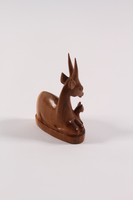
Kenyan wood sculpture of two gazelles owned by a German Jewish refugee family
Object
Carved wooded sculpture of an adult gazelle with one young offspring acquired by Gisela Berg and her family in Kenya where they lived after fleeing Cologne, Germany, in May/June 1939. The family was warned by neighbors to leave their home in Lechenich prior to the Kristallnacht pogrom of November 9-10, 1938. Their homes were vandalized and the family decided to leave Germany. Jill's father Josef, his brother George, and cousin Ernest fled to the Netherlands. They were arrested, but their uncle, Herman Meyer, hired a lawyer and the men were detained but not deported. This gave the family time to find a country where they could emigrate legally. A family friend got them permits for British-ruled Kenya and eventually seventeen family members relocated to a cattle ranch near Nairobi. When the war ended in May 1945, the family decided to leave Africa. They obtained visas with the help of two cousins in the US. Gisela, 14, her sister Inge, 18, her parents Josef and Klara, and other family members arrived in Boston in March 1947.
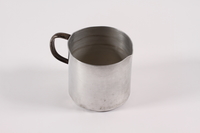
Aluminum pitcher used by a German Jewish family forced to emigrate
Object
Aluminum pitcher used by Gisela Berg and her extended family when they fled Cologne, Germany, in May/June 1939. The family was warned by neighbors to leave their home in Lechenich prior to the Kristallnacht pogrom of November 9-10, 1938. Their homes were vandalized and the family decided to leave Germany. Jill's father Josef, his brother George, and cousin Ernest fled to the Netherlands. They were arrested, but their uncle, Herman Meyer, hired a lawyer and the men were detained but not deported. This gave the family time to find a country where they could emigrate legally. A family friend got them permits for British-ruled Kenya and eventually seventeen family members relocated to a cattle ranch near Nairobi. When the war ended in May 1945, the family decided to leave Africa. They obtained visas with the help of two cousins in the US. Gisela, 14, her sister Inge, 18, her parents Josef and Klara, and other family members arrived in Boston in March 1947.
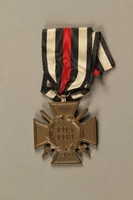
Medal with ribbon
Object
Iron Cross medal with the dates 1914-1918 surrounded by a laurel wreath on one side, and the words "R.V. Pforzheim" on the other side. The medals belonged to Hugo Pauly.
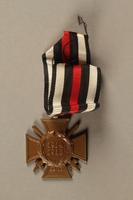
Medal with ribbon
Object
Iron Cross medal with the dates 1914-1918 surrounded by a laurel wreath on one side, and the words "R.V. Pforzheim" and the number 85 on the other side. The medals belonged to Hugo Pauly.
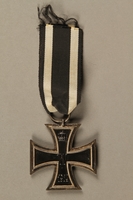
Medal with ribbon
Object
Iron Cross medal with the date 1914 and the letter "W" on one side and the initials "FW" and the date of 1813 on the other side. The medals belonged to Hugo Pauly.
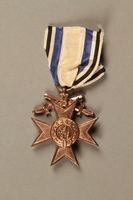
Medal with ribbon
Object
Copper colored medal with ribbon. The medal has the word "Merenti" on one side and the date "1866" on the other. The medal depicts crossed swords as well as a lion. The medals belonged to Hugo Pauly.
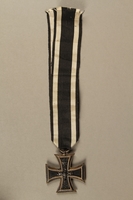
Medal with ribbon
Object
Iron Cross medal with the date 1914 and the letter "W" on one side and the initials "FW" and the date of 1813 on the other side. The medals belonged to Hugo Pauly.
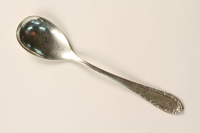
Silver teaspoon engraved Hilde given to a Jewish girl in prewar Germany
Object
Child's spoon engraved with her name and given to Hilde Hermanns circa 1930, when she was a 7 year old child in Monchengladbach, Germany. When Hitler came to power in Germany in 1933, Hilde and her parents, Julius and Margarete (Grete), lived comfortably in Monchengladbach where her father ran a dry goods store with his siblings. The Nazi regime increasingly persecuted Jews, boycotting and taking away their businesses. Julius was arrested in September 1938 and sent to Dachau, and then Buchenwald concentration camp. He was released in April 1939, with the condition that he leave the country. He left on the MS St Louis, but it was forced to return from Cuba with nearly all passengers. Julius was given refuge in France, but interned after Germany invaded Poland in September and France declared war. Hilde was assigned as forced labor in a factory in July 1940. In December 1941, Hilde, her mother, Grete, and paternal aunt Sophie were deported to the Riga ghetto in German occupied Latvia. Julius was deported to Auschwitz in August 1942, and killed. On October 1, 1944, Hilde, 19, and Margarete, 45, were transferred to Stutthof concentration camp, where they perished. The spoon was preserved by her cousin, Jill Berg, whose family fled Lechenich, Germany, just before Kristallnacht in November 1938, and left for Kenya in May/June 1939.
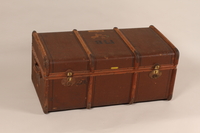
Burlap covered steamer trunk used by a German Jewish family
Object
Steamer trunk labelled Mombasa used by Max and Clara Davids Berg and their extended family when they fled Cologne, Germany, in May/June 1939. The family was warned by neighbors to leave their home in Lechenich prior to the Kristallnacht pogrom of November 9-10, 1938. Their homes were vandalized and the family decided to leave Germany. Max's sons, Josef and George, and cousin Ernest fled to the Netherlands. They were arrested, but their uncle, Herman Meyer, hired a lawyer and the men were detained but not deported. This gave the family time to find a country where they could emigrate legally. A family friend got them permits for British-ruled Kenya and eventually seventeen family members relocated to a cattle ranch near Nairobi during the war. Max died in 1942 and Clara in 1945. When the war ended in May 1945, the family decided to leave Africa. With the help of two cousins in the US, visas were obtained for the family. Josef, his wife Klara Meyer, and daughters, Inge, 18, and Jill, 14, used the trunk to emigrate to the US. Along with other family members, they arrived in Boston in mid-march 1947.
Berg and Hermanns families photographs
Document
Contains photographs documenting the experiences of Clara and Max Berg and their extended family in Germany before their escape to Kenya, and their life in Kenya during the Holocaust.



